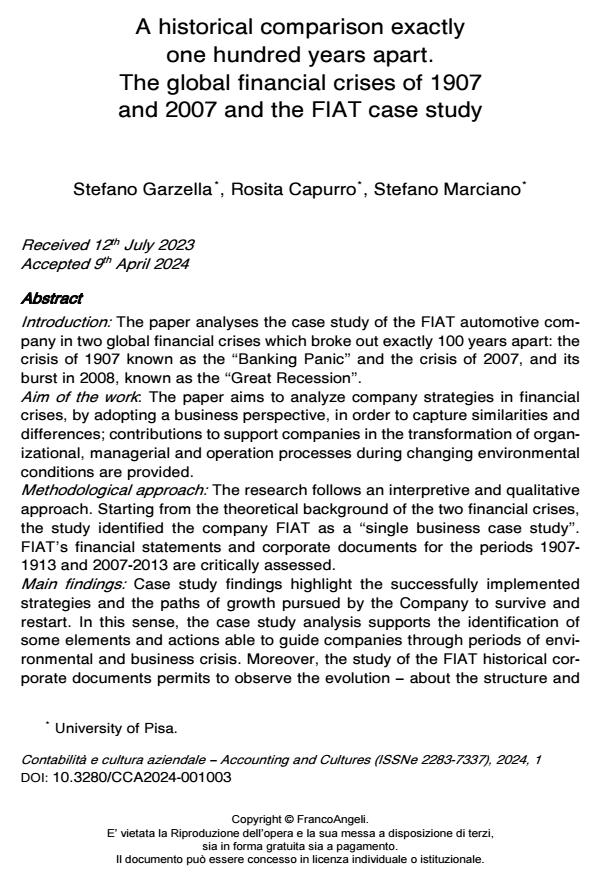A historical comparison exactly one hundred years apart. The global financial crises of 1907 and 2007 and the FIAT case study
Journal title CONTABILITÀ E CULTURA AZIENDALE
Author/s Stefano Garzella, Rosita Capurro, Stefano Marciano
Publishing Year 2024 Issue 2024/1
Language English Pages 35 P. 43-77 File size 273 KB
DOI 10.3280/CCA2024-001003
DOI is like a bar code for intellectual property: to have more infomation
click here
Below, you can see the article first page
If you want to buy this article in PDF format, you can do it, following the instructions to buy download credits

FrancoAngeli is member of Publishers International Linking Association, Inc (PILA), a not-for-profit association which run the CrossRef service enabling links to and from online scholarly content.
Introduction: The paper analyses the case study of the FIAT automotive company in two global financial crises which broke out exactly 100 years apart: the crisis of 1907 known as the “Banking Panic” and the crisis of 2007, and its burst in 2008, known as the “Great Recession”. Aim of the work: The paper aims to analyze company strategies in financial crises, by adopting a business perspective, in order to capture similarities and differ-ences; contributions to support companies in the transformation of organizational, managerial and operation processes during changing environmental conditions are provided. Methodological approach: The research follows an interpretive and qualitative ap-proach. Starting from the theoretical background of the two financial crises, the study identified the company FIAT as a “single business case study”. FIAT’s financial statements and corporate documents for the periods 1907-1913 and 2007-2013 are critically assessed. Main findings: Case study findings highlight the successfully implemented strate-gies and the paths of growth pursued by the Company to survive and restart. In this sense, the case study analysis supports the identification of some elements and actions able to guide companies through periods of environmental and business crisis. Moreover, the study of the FIAT historical corporate documents permits to observe the evolution – about the structure and the content – of corporate disclo-sure over time. Originality: There is a lack of studies that analyze and compare the two crises. The comparison between the two financial crises by adopting a business perspective is novel. The historical comparison together with the analysis of the evolution of the FIAT’s corporate disclosure over time, provides relevant scientific insights, poten-tially able to favour an advancement of knowledge to help companies in the trans-formation and adaptation processes to changing environmental conditions.
Keywords: global financial crises, case study, financial statement, corporate disclo-sure, historical comparison.
Stefano Garzella, Rosita Capurro, Stefano Marciano, A historical comparison exactly one hundred years apart. The global financial crises of 1907 and 2007 and the FIAT case study in "CONTABILITÀ E CULTURA AZIENDALE" 1/2024, pp 43-77, DOI: 10.3280/CCA2024-001003